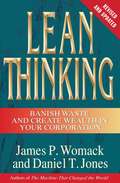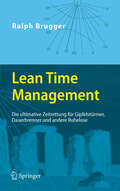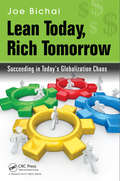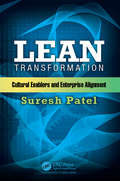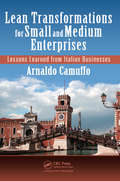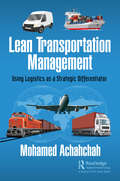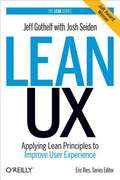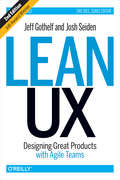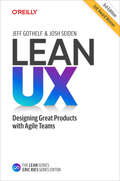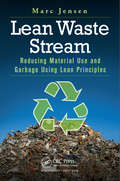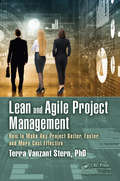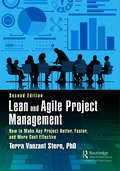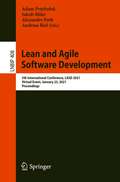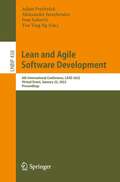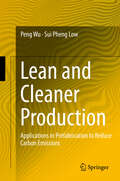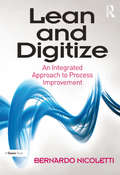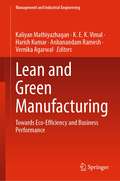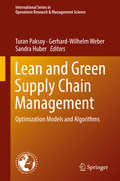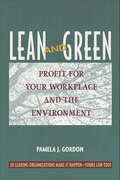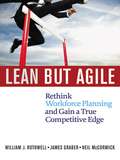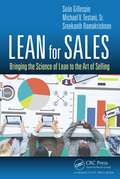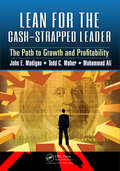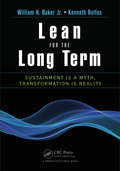- Table View
- List View
Lean Thinking: Banish Waste and Create Wealth in Your Corporation
by James P. Womack Daniel T. JonesExpanded, updated, and more relevant than ever, this bestselling business classic by two internationally renowned management analysts describes a business system for the twenty-first century that supersedes the mass production system of Ford, the financial control system of Sloan, and the strategic system of Welch and GE. It is based on the Toyota (lean) model, which combines operational excellence with value-based strategies to produce steady growth through a wide range of economic conditions. In contrast with the crash-and-burn performance of companies trumpeted by business gurus in the 1990s, the firms profiled in Lean Thinking -- from tiny Lantech to midsized Wiremold to niche producer Porsche to gigantic Pratt & Whitney -- have kept on keeping on, largely unnoticed, along a steady upward path through the market turbulence and crushed dreams of the early twenty-first century. Meanwhile, the leader in lean thinking -- Toyota -- has set its sights on leadership of the global motor vehicle industry in this decade. Instead of constantly reinventing business models, lean thinkers go back to basics by asking what the customer really perceives as value. (It's often not at all what existing organizations and assets would suggest.) The next step is to line up value-creating activities for a specific product along a value stream while eliminating activities (usually the majority) that don't add value. Then the lean thinker creates a flow condition in which the design and the product advance smoothly and rapidly at the pull of the customer (rather than the push of the producer). Finally, as flow and pull are implemented, the lean thinker speeds up the cycle of improvement in pursuit of perfection. The first part of this book describes each of these concepts and makes them come alive with striking examples. Lean Thinking clearly demonstrates that these simple ideas can breathe new life into any company in any industry in any country. But most managers need guidance on how to make the lean leap in their firm. Part II provides a step-by-step action plan, based on in-depth studies of more than fifty lean companies in a wide range of industries across the world. Even those readers who believe they have embraced lean thinking will discover in Part III that another dramatic leap is possible by creating an extended lean enterprise for each of their product families that tightly links value-creating activities from raw materials to customer. In Part IV, an epilogue to the original edition, the story of lean thinking is brought up-to-date with an enhanced action plan based on the experiences of a range of lean firms since the original publication of Lean Thinking. Lean Thinking does not provide a new management "program" for the one-minute manager. Instead, it offers a new method of thinking, of being, and, above all, of doing for the serious long-term manager -- a method that is changing the world.
Lean Time Management
by Ralph BruggerDer Autor bietet seinen Lesern in diesem Band eine Mischung aus intelligentem Infotainment und unterhaltsamem Leseabenteuer: In erheiternden Zeitreisen transportiert er auf ungewöhnliche Art und Weise Erkenntnisse über die Zeit. Für den Umgang mit der Zeit liefert er überraschende Anregungen und empfiehlt zwei Sofortmaßnahmen, mit denen jeder gerettet werden kann, der unter Zeitnot leidet. Das Buch des Autors ist die ungewöhnlichste "Zeitrettungsaktion", seit es Zeitmanagement gibt.
Lean Today, Rich Tomorrow: Succeeding in Today's Globalization Chaos
by Joe BichaiThis book tells the story of an actual Lean transformation that took place in a 100-year-old North American manufacturer's factory. Lean Today, Rich Tomorrow: Succeeding in Today's Globalization Chaos describes how an obsolete factory destined for closure was transformed into the most productive North American manufacturer in its field. It describes how the company eliminated the bad habits associated with its antiquated push system and transformed its factory into a JIT/Lean philosophy-driven plant with one-piece flow, U-shaped production lines, and productivity sharing.
Lean Transformation: Cultural Enablers and Enterprise Alignment
by Suresh PatelBooks in the Quality and Business Excellence series can help readers improve customer value and satisfaction by integrating the voice of the customer into design, manufacturing, supply chain, and field processes. Lean Transformation: Cultural Enablers and Enterprise Alignment is about the Lean system. It begins by describing the reasons why so many Lean implementations fail and explaining why managers need to focus their valuable time on early adopters rather than on trying to convert resistors.This book describes the guiding principles of the Shingo process for continuous improvement layout and evaluation. It examines the principles, systems, and tools of continuous improvement and demonstrates how to deploy these proven methods in plants and distribution centers.The book covers time-tested continuous improvement process tools and practices, including the visual workplace, mistake proofing, PDCA, 5S, Heijunka, standard work, Kaizen, and value stream mapping. It also examines Lean performance measures and introduces a comprehensive Lean tool assessment system.Presenting seven proven techniques for altering and guiding a Lean culture, the book identifies a formal process for overcoming common roadblocks. It also illustrates the proliferation of the Lean initiative across an organization's various sites. This book describes how proper assessment of Lean system tools can help your organization remain focused on system standardization and boost your organization’s sustainability efforts. It includes job descriptions of various roles in the improvement process, including those for Lean supervisor and Lean team leader, as well as a glossary that defines key terms.
Lean Transformations for Small and Medium Enterprises: Lessons Learned from Italian Businesses
by Arnaldo CamuffoLean Transformations for Small and Medium Enterprises: Lessons Learned from Italian Businesses summarizes two decades of research, teaching, and practice on lean thinking. Based on quantitative analysis of 100 cases of Lean transformations and 20 in-depth case studies of successfully transformed SMEs, it explains how to undertake lean transformations that lead to operational and financial performance improvement, and uses the Lean Transformation Framework --conceptualized by John Shook at the Lean Enterprise Institute—as a practical approach to design and de-risk the transformation process. SMEs’ leaders wishing to undertake and sustain a lean transformation must: Make a serious and lasting commitment to transform, avoiding the temptation to change course of action; Choose accurately the value streams that require improvement as defined by strategy deployment; Build capabilities to sustain the transformation; Lead by example by going to gemba and creating a culture of respect for people that goes beyond the visible devices and artifacts of Lean tools.
Lean Transportation Management: Using Logistics as a Strategic Differentiator
by Mohamed AchahchahThis book provides an overview of the key transportation management processes from a shipper’s perspective. It enables managers to gain quick insight in the added value of transportation as a strategic differentiator, its key drivers, and guidelines on how to use them in an effective and efficient decision-making process. It explains how to identify and eliminate waste using basic Lean tools and proven concepts. The reader is guided on how to start implementing the Lean methodology and best practices in the industry to realize significant savings.Companies such as Adidas and Amazon are using transportation to increase sales by delivering purchased products faster than the competition. These companies do not treat transportation as a cost center. They are not focusing on reducing transportation spending. They allow customers to buy any product that is available in any store or warehouse and have it delivered to their homes. By delivering faster than the competition, they increase sales. At the same time, they lower their total supply chain costs as faster deliveries lead to fewer returns. Reduction of returns means higher sales and lower transportation costs for returns. The result is higher profits while creating more value for the customer.Transportation is moving from a cost center towards a profit center. The traditional logistics service providers are perceived to not innovate fast enough. Top management must understand the transportation management basics and use it in their strategic decision-making. They should be involved in discussions on how to organize the transport management function in the best way and how to use it as a service differentiator. Transportation is more than the efficient movement of supplies, sub-assemblies and final products. In addition, it is more than the key performance indicators on the business-balanced scorecard. Transportation management professionals fail to catch top management’s attention due to the use of technical language. It is more difficult to understand transportation key performance indicators such as loading degree, net and gross pick-up and delivery reliability. It is easier to get top management attention when talking about lost sales due to stock-outs, lost tenders due to long delivery times, high inventory holding and scrap costs.
Lean UX: Applying Lean Principles to Improve User Experience
by Jeff Gothelf Josh Seiden<p>The Lean UX approach to interaction design is tailor-made for today’s web-driven reality. In this insightful book, leading advocate Jeff Gothelf teaches you valuable Lean UX principles, tactics, and techniques from the ground up—how to rapidly experiment with design ideas, validate them with real users, and continually adjust your design based on what you learn.</p>
Lean UX: Designing Great Products with Agile Teams
by Jeff Gothelf Josh SeidenUX design has traditionally been deliverables-based. Wireframes, site maps, flow diagrams, content inventories, taxonomies, mockups helped define the practice in its infancy.Over time, however, this deliverables-heavy process has put UX designers in the deliverables business. Many are now measured and compensated for the depth and breadth of their deliverables instead of the quality and success of the experiences they design. Designers have become documentation subject matter experts, known for the quality of the documents they create instead of the end-state experiences being designed and developed.So what's to be done? This practical book provides a roadmap and set of practices and principles that will help you keep your focus on the the experience back, rather than the deliverables.Get a tactical understanding of how to successfully integrate Lean and UX/DesignFind new material on business modeling and outcomes to help teams work more strategicallyDelve into the new chapter on experiment designTake advantage of updated examples and case studies
Lean UX: Designing Great Products with Agile Teams
by Jeff Gothelf Josh SeidenLean UX is synonymous with modern product design and development. By combining human-centric design, agile ways of working, and a strong business sense, designers, product managers, developers, and scrum masters around the world are making Lean UX the leading approach for digital product teams today.In the third edition of this award-winning book, authors Jeff Gothelf and Josh Seiden help you focus on the product experience rather than deliverables. You'll learn tactics for integrating user experience design, product discovery, agile methods, and product management. And you'll discover how to drive your design in short, iterative cycles to assess what works best for businesses and users. Lean UX guides you through this change--for the better.Facilitate the Lean UX process with your team with the Lean UX CanvasEnsure every project starts with clear customer-centric success criteriaUnderstand the role of designer on an agile teamWrite and contribute design and experiment stories to the backlogEnsure that design work takes place in every sprintBuild product discovery into your team's "velocity"
Lean Waste Stream: Reducing Material Use and Garbage Using Lean Principles
by Marc JensenThe fact that a process produces garbage is a testament to design inefficiency, and this book explains how to use the nature of that garbage to pinpoint and eliminate those inefficiencies. Lean Waste Stream: Reducing Material Use and Garbage Using Lean Principles supplies an unprecedented look at how to address business waste in a manner that will improve your organization‘s environmental and financial performance.Tackling the problem of business garbage from a Lean perspective, the book maintains a focus on how to minimize garbage in ways that cut costs. It considers the problem of garbage in terms of transportation, inventory, and labor costs with an effort to connect reductions in garbage production at all stages with lower operating costs and improved productivity.Explaining how to use garbage analysis as a tool to identify the problems in process flow that produced the garbage, this book describes how to look downstream for options to reuse, repurpose, and recycle garbage to minimize landfill impact and costs. The text includes practical exercises with step-by-step instructions, as well as real-world examples that illustrate how specific wastes have been dealt with profitably by various organizations.
Lean and Agile Project Management: How to Make Any Project Better, Faster, and More Cost Effective
by Terra Vanzant Stern, PhDWhen project managers are faced with budget cuts and fewer resources, waste elimination becomes a priority in maintaining effectiveness. This does not mean shortening or abandoning traditional project cycles, though. In fact, fast results on critical assignments can only be completed with strong plans and a detailed work-breakdown structure. The connections, or lack thereof, are what strongly impact performance and quality. This book defines nine wastes found in project management and demonstrates how they can be addressed with lean technology.
Lean and Agile Project Management: How to Make Any Project Better, Faster, and More Cost Effective, Second Edition
by Terra Vanzant Stern, PhDWhen project managers are faced with budget cuts and fewer resources, waste elimination becomes a priority in maintaining effectiveness. This does not mean shortening or abandoning traditional project cycles. In fact, fast results on critical assignments can only be completed with strong plans and a detailed work breakdown structure. The connections, or lack thereof, are what strongly impact performance and quality. Lean and Agile, as covered in this book, are meant to enhance traditional project management, not replace the science. A strong foundation in traditional project management is necessary to appreciate the benefits of adopting Lean and Agile. Lean and Agile Project Management: How to Make Any Project Better, Faster, and More Cost Effective defines the wastes and issues found in project management and demonstrates how they can be addressed by engaging Lean thinking and Agile techniques. This book also: • Shows how to apply Lean principles to project management (PM) • Teaches the application of simple Six Sigma metrics in PM • Discusses the adoption of Agile techniques in PM in order to stay on task and remain flexible • Helps readers discover the theoretical synergies between popular PM programs • Promotes an understanding of how Lean people skills can help a person become a better leader and manager Since the publication of the first edition of this book, the bodies of knowledge have all been systematically updated. In addition, through conducting peer groups and detailed workshops, the Author has simplified many of the basics, and they are now much easier to understand. Essentially, the Author believes traditional project management can benefit from adding Lean and Agile, but she has simplified the model for greater efficiency.
Lean and Agile Software Development: 5th International Conference, LASD 2021, Virtual Event, January 23, 2021, Proceedings (Lecture Notes in Business Information Processing #408)
by Alexander Poth Adam Przybyłek Jakub Miler Andreas RielThis book constitutes the proceedings of the 5th International Conference on Lean and Agile Software Development, LASD 2021, which was held online on January 23, 2021. The conference received a total of 32 submissions, of which 10 full and 2 short papers are included in this volume. In addition, one keynote paper is also included. To live the agile mindset, the LASD conference focuses on highly relevant research outcomes and fosters their way into practice. Topics discussed in this volume range from teams under COVID-19 through women in Agile, to product road-mapping and non-functional requirements.
Lean and Agile Software Development: 6th International Conference, LASD 2022, Virtual Event, January 22, 2022, Proceedings (Lecture Notes in Business Information Processing #438)
by Adam Przybyłek Aleksander Jarzębowicz Ivan Luković Yen Ying NgThis book constitutes the proceedings of the 6th International Conference on Lean and Agile Software Development, LASD 2022, which was held online on January 22, 2022. The conference received a total of 29 submissions, of which 9 full papers, 1 short paper and 1 position paper are included in this volume. In addition, the volume contains one keynote paper in full paper length. Topics discussed in this volume cover various aspects of agile software development and range from agile testing, to agile effort estimation, an agile approach to model-driven development, and remotely working agile teams.
Lean and Cleaner Production
by Sui Pheng Low Peng WuThis book explains how in moving towards Cleaner Production, the Lean Production Philosophy can be applied to reduce carbon emissions in prefabrication - one major source of the Greenhouse Gas (GHG) emissions which contribute to global climate change. This book examines theories and principles in the Lean Production Philosophy to develop situation-based carbon reduction strategies for precast concrete manufacturers and contractors in terms of Site layout, Supply Chain, Production, Stocks and Installation Management. It presents the empirical findings of surveys and case studies with managers and professionals working for precasters and contractors in Singapore, findings which provide good practical guidance for precast concrete manufacturers and contractors to achieve low carbon emissions and to perform better in many sustainability-based rating systems, such as the Singapore Green Labelling Scheme and the Building and Construction Authority (BCA) Green Mark Scheme.
Lean and Digitize: An Integrated Approach to Process Improvement
by Bernardo NicolettiLean and Six Sigma initiatives are designed to enable sustained improvements in your company or organization's efficiency and competitiveness. As with other improvement strategies they are dependent on two things, effective management and your ability to automate or digitize elements of your business process. Lean and Digitize provides you with a convincing picture of each of these elements (process improvement, digitization and the management of both) to help you eliminate waste, improve process and service, and better align your information and communications technology with your strategic objectives. Bernardo Nicoletti analyses and reviews the development of automation and telecommunications systems in the context of quality management and process improvement. He uses case examples to illustrate organizational and management approaches to implementation. These, along with his practical guidance, will help you make sense of the complexity, benefits and interrelations between these different elements. The text shows you on the one hand, how to integrate information and communication systems into your process improvement projects and, on the other, how to align information and communication projects with your quality strategy. Without a holistic approach to technology and quality improvement, your initiatives run the risk of being misdirected or simply running out of steam. Changes of this kind will never be easy but at least if you follow the advice in Lean and Digitize you will significantly increase your chances of success.
Lean and Green Manufacturing: Towards Eco-Efficiency and Business Performance (Management and Industrial Engineering)
by Harish Kumar Kaliyan Mathiyazhagan K. E. K. Vimal Anbanandam Ramesh Vernika AgarwalThis book provides a stage-by-stage integration of lean and green manufacturing paradigms to achieve environmental and economic benefits. The book includes chapters on conceptual development for incorporating the lean and green paradigm, and methods, tools and techniques for developing and integrating lean manufacturing. Several case studies which demonstrate the benefits of integrating lean and green manufacturing techniques are also covered here. The contents of this book are expected to support researchers and practitioners in the implementation of integrated lean and green manufacturing technologies.
Lean and Green Supply Chain Management: Optimization Models and Algorithms (International Series in Operations Research & Management Science #273)
by Gerhard-Wilhelm Weber Turan Paksoy Sandra HuberThis book presents the latest developments in optimization and optimal control models; exact, approximate and hybrid methods; and their applications in lean and green supply chains. It examines supply chain network design and modeling, closed loop supply chains, and lean, green, resilient and agile or responsive networks, and also discusses corporate social responsibility and occupational health and safety. It particularly focuses on supply chain management under uncertainty – employing stochastic or nonlinear modeling, simulation based studies and optimization – multi-criteria decision-making and applications of fuzzy set theory, and covers various aspects of supply chain management such as risk management, supplier selection or the design of automated warehouses. Lastly, using experimental applications and practical case studies, it shows the impact of lean and green applications on vehicle/fleet management and operations management.
Lean and Green: Profit for Your Workplace and the Environment
by Pamela J GordonWhen it comes to believing that business can be profitable and environmentally sensitive, cynics abound on both sides. But in Lean and Green, Pamela Gordon proves that capitalism and environmentalism are not mutually exclusive-quite the contrary. She shows how "green" business practices enable organizations to save millions, even billions of dollars each year. Lean and Gree chronicles over one hundred examples of how people in twenty different organizations around the world-from clerks, farmers, and city employees to chemists and executives-have strengthened environmental practices and the balance sheet. She details waste-saving, profit-building acts as basic as Linda Gee at LSI Logic digging out usable pre-worn shoe covers to wear in the clean room, and as broad as the city of Santa Monica paving residential streets with white top to reduce urban heat and increase surface longevity. Drawing on her background as a leading business consultant, Gordon shows readers precisely how to sell their environmental ideas to management. She describes how to make the case in no-nonsense business terms, set concrete goals that the new practices will achieve, measure the economic results of the new practices, and make sure the right people hear about the results so that environmental initiatives continue. Each chapter includes a "Making It Easy" list of action steps for implementing lean and green improvements in the workplace easily and immediately. Lean and Green will inspire employees and employers alike to explore creative ways to simultaneously save the planet and bolster the bottom line.
Lean at Wipro Technologies
by Bradley R. Staats David M. UptonWipro Technologies, a rapidly growing software services firm based in India, decided to use principles from the Toyota Production System (also known as lean) to fundamentally change their operating model. Looks at why Wipro chose to use lean and how they went about implementing it in a novel context such as this. Provides detail of Wipro's internal and external environment, which was necessitating the change (shift from delivering a low-cost product to providing a business solution). Also, explores whether this new approach can lead to a substantial competitive advantage.
Lean but Agile: Rethink Workforce Planning and Gain a True Competitive Edge
by Neil Mccormick William J. Rothwell James GraberAs organizations strive to maximize efficiency to meet stringent budgets, a general "do more with less" mandate is no longer sufficient. Managers and executives must evaluate every process and every role, and do away with assumptions about how work gets done and who does it. Lean but Agile presents a system for analyzing work and selecting the ideal combination of cost-effective resources-employees, consultants, contractors, temporary workers, vendors-to accomplish it. The book advocates changes in hiring, goal-setting, learning and development, and performance management, and discusses the introduction, implementation, and management of lean work and agile staffing methods. It also explores the fundamental role technology can play in the transformation. Packed with practical advice, examples, guides, worksheets, diagrams, and metrics, Lean but Agile will help leaders, managers, and human resource professionals optimize their workforces while still achieving superior results.
Lean for Banks: Improving Quality, Productivity, and Morale in Financial Offices
by Bohdan W. Oppenheim Marek FelburMost banking institutions suffer from numerous inefficiencies, such as poor planning; inadequate coordination and communication; ineffective processes, tools, and workflow; and excessive bureaucracy. Lean for Banks describes in easy language how to use Lean and Six Sigma management practices to significantly improve the efficiency of bank operation
Lean for Sales: Bringing the Science of Lean to the Art of Selling
by Sean Gillespie Michael V. Testani Sr. Sreekanth RamakrishnanThis groundbreaking book describes the Lean journey as it extends to a business area that is mission critical, yet has been virtually untouched by the Lean transformation. Lean for Sales: Bringing the Science of Lean to the Art of Selling provides sales professionals, and their management teams, with a structured, fact-based approach to boosting sa
Lean for the Cash-Strapped Leader: The Path to Growth and Profitability
by Mohammad Ali John E. Madigan Todd C. MaherCreated by Lean practitioners with real-world, results-proven track records, this book is designed to help struggling managers and leaders, interested in the benefits of Lean but bereft of budgets to hire full-time consultants, start substantial change in their enterprises and begin to reap the benefits of Lean.At once a how-to manual and a strategic management guide, the book lays out, in simple English, all the steps for implementing Lean, from formulating a strategy and managing organizational change, to establishing a kanban-driven, level-loaded production system.Presenting strategies that will fit in most existing budgets, Lean for the Cash-Strapped Leader: The Path to Growth and Profitability uses easy-to-read language with flashes of humor to reveal proven methods that will help your organization initiate change and begin reaping the rewards of a Lean operations system in any industry.The book avoids acronyms, complex Lean terminology, and academic froth to convey the essential instructions, detail, and information you need. Identifying powerful methods for initiating a Lean value stream that require minimal investment, the book is designed to help owners of small businesses and senior managers of larger ones make their enterprises more efficient, more productive, and ultimately more profitable.Along the way, the book gives detailed attention to the need for the "soft message" that underwrites and supports the actions required for a business to achieve the transformation that Lean can bring. Lean for the Cash-Strapped Leader emphasizes the messaging and the degree of management involvement required to achieve a successful Lean result. Learn more about the book at: http://www.leanforthecashstrappedleader.com/
Lean for the Long Term: Sustainment is a Myth, Transformation is Reality
by William H. Baker Jr. Kenneth RolfesThe average tenure of a departing CEO has declined from approximately 10 years in 2000 to 8.1 years in 2012. Maintaining a customer-focused Lean strategy and continuous improvement culture can become a challenge when management changes often, unless it has become an institutionalized company-branded business management system for the company.Lean f
